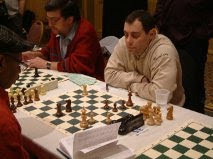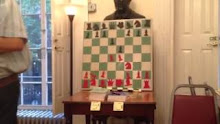The main line in ECO is now 7...Qd7. What happens if Black tries 7...Qe7 instead? In a footnote, ECO gives Keres's analysis 8.d5 Nd4 9.Qa4+ Qd7 10.Qxa5 b6 11.Nxd4 bxa5 12.Bb5 exd4 13.Bxd7+ Bxd7 14.cxd4 +/=.
Tim Harding, in his book on the Evans Gambit, gives 13...Kxd7! 14.cxd4 f5! =, Cranbourne-Juarez, River Plate 1984, as an improvement for Black. Besides 7...Qe7 8.d5 Nd4 9.Nxd4 exd4 10.O-O Bb6 11.Bb2 with compensation (Keres), Harding mentions that 11.Bb5+ Kf8 12.Nd2 is another positional continuation for White.
After 7...Qe7, the game Morphy-Ayers, Mobile 1855 proceeded in tactical fashion with 8.d5 Nd4 9.Bb5+ c6 10.Nxd4 exd4 11.dxc6 Qxe4+ 12.Kd1 Bg4+ 13.f3 Bxf3+ 14.gxf3 Qxf3+ 15.Kc2 Qe4+ 16.Kb2 Bxc3+ 17.Nxc3 dxc3+ 18.Qxc3 O-O-O 19.Re1 Qd5 20.cxb7+ Kxb7 21.Rb1 Nf6 22.Bc6+ Qxc6 23.Ka1+ Kc7 24.Qa5+ Kc8 25.Qxa7 Nd7 26.Bd2, Black resigns.
Recently* I have played several games as White against candidate master Ed Kopiecki at the Marshall Chess Club in which the same move order through 15.Kc2 has been followed.
In May 1995, Kopiecki omitted 15...Qe4+ in favor of 15...bxc6 16.Re1+ Ne7 17.Nd2 Qxc3+ 18.Qxc3 Bxc3 19.Bxc6+ Kd8 20.Bxa8 Bxa1 21.Ba3 Bc3 22.Bxd6 Nf5 23.Bf4 Kd7 24.Be4 Nd6 25.Bd5 Rc8 26.Bxd6 Kxd6 27.Bxf7 Ba5+ 28.Kd1 d3 29.Nc4+ +/-and White won in 47 moves.
In July 1995, Kopiecki played 15...Qe4+ 16.Kb2 bxc6, as recommended by Maroczy. Our game continued 17.Rd1 Ne7 18.Rxd4 (an improvement on Maroczy's 18.Bd3 Qh4) Qg2+ 19.Rd2 Qh1 20.Re2?! (20.Bd3!?) O-O 21.Bf4 Nd5 22.Bxd6 cxb5 23.Bxf8 Rxf8 when Black already stood better and won in 42 moves.
No doubt Kopiecki found an improvement for White in home analysis because, in our next game later that month, he varied with 18...Qe5 (instead of 18...Qg2+). But this led to victory for White in 37 moves after 19.Na3 Qxh2+ 20.Rd2 Qh4 21.Rd4 Qh2+ 22.Nc2 O-O 23.Bf4 Qh5 24.Bxd6 Nf5 25.Bxf8 Nxd4 26.Nxd4 Rxf8 27.Nxc6 +/-.
*{This article originally appeared in the November-December 1995 issue of Atlantic Chess News}




























